Abstract
Sciatic nerve palsy after total knee arthroplasty, accompanied by motor power weakness and electromyographic evidence, is a rare occurrence. In a 78-year-old female, pneumatic tourniquet was used for 72 minutes, with a pressure of 300 mmHg. The time and pressure are generally accepted values. We noticed sciatic nerve palsy showing motor power weakness and electromyographic evidence. One year after the operation, she recovered full motor power, but complained about a tingling sensation below the knee. Given that the nerve injury after using tourniquet was due to neural ischemia, and since our patient had vascular circulation problems such as atrial fibrillation and clip insertion due to internal carotid artery aneurysm, our patient can be considered as a high-risk patient with weakness to neural ischemic damage, even with the use of conventional tourniquet. Therefore, surgeons should be cautious when using tourniquet in patients with vascular circulation problems.
Go to : 
REFERENCES
1. Schinsky MF, Macaulay W, Parks ML, Kiernan H, Nercessian OA. Nerve injury after primary total knee arthroplasty. J Arthroplasty. 2001; 16:1048–54.

2. Park JH, Restrepo C, Norton R, Mandel S, Sharkey PF, Parvizi J. Common peroneal nerve palsy following total knee arthroplasty: prognostic factors and course of recovery. J Arthroplasty. 2013; 28:1538–42.
3. Olivecrona C, Blomfeldt R, Ponzer S, Stanford BR, Nilsson BY. Tourniquet cuff pressure and nerve injury in knee arthroplasty in a bloodless field: a neurophysiological study. Acta Orthop. 2013; 84:159–64.
4. Asp JP, Rand JA. Peroneal nerve palsy after total knee arthroplasty. Clin Orthop Relat Res. 1990; 261:233–7.
5. Myers MA, Harmon RL. Sacral plexopathy and sciatic neuropathy after total knee arthroplasty. Electromyogr Clin Neurophysiol. 1998; 38:423–6.
6. Horlocker TT, Cabanela ME, Wedel DJ. Does postoperative epidural analgesia increase the risk of peroneal nerve palsy after total knee arthroplasty? Anesth Analg. 1994; 79:495–500.

7. Johanson NA. Neurovascular complications following total knee replacement: causes, treatment, and prevention. Instr Course Lect. 1997; 46:181–4.
8. Horlocker TT, Hebl JR, Gali B. . Anesthetic, patient, and surgical risk factors for neurologic complications after prolonged total tourniquet time during total knee arthroplasty. Anesth Analg. 2006; 102:950–5.

Go to : 
 | Figure 1Sciatic nerve (arrow) around distal thigh (A) and common peroneal nerve (2 arrows) around the fibular head had no abnormality in an ultrasonography (B). |
 | Figure 2The patient underwent total knee arthroplasty due to varus knee osteoarthritis. Preoperation (A) and postoperation (B). |
Table 1
Leg Motor Power Taken 2 Days after the Operation
| Variable | Right leg motor power grade | Left leg motor power grade |
|---|---|---|
| Knee extension | 5 | 5 |
| Knee flexion | 5 | 5 |
| Ankle dorsi- flexion | 5 | 1 |
| Ankle plantar- flexion | 5 | 3 |
| Great toe dorsi- flexion | 5 | 1 |
Table 2
Result of Electromyography Taken 3 Weeks after the Operation
| Muscle | Nerve | Spontaneous PSW |
|---|---|---|
| Left tibialis anterior | Deep peroneal | 3+ |
| Left peroneus longus | Superficial peroneal | 3+ |
| Left gastrocnemius | Tibial | 2+ |
| Left vastus lateralis | Femoral | None |
Table 3
Leg Motor Power Taken 4 Months after the Operation
| Variable | Right leg motor power grade | Left leg motor power grade |
|---|---|---|
| Knee extension | 5 | 5 |
| Knee flexion | 5 | 5 |
| Ankle dorsi- flexion | 5 | 4 |
| Ankle plantar- flexion | 5 | 4 |
| Great toe dorsi- flexion | 5 | 4 |




 PDF
PDF ePub
ePub Citation
Citation Print
Print


 XML Download
XML Download